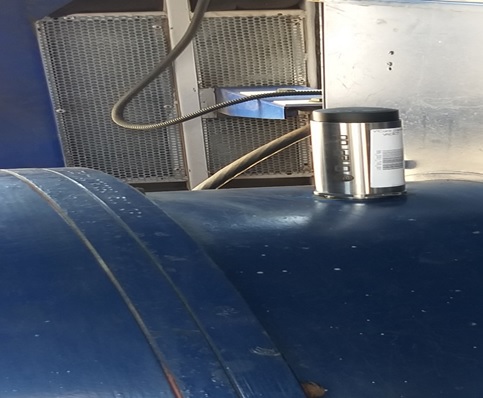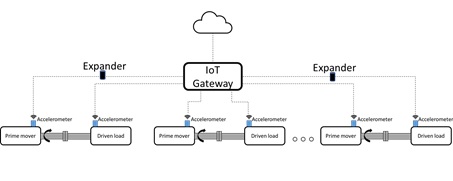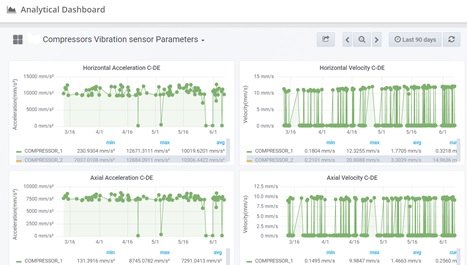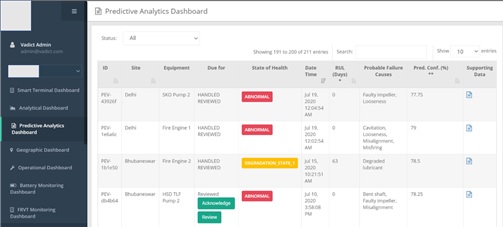IIoT Backed Predictive Maintenance Solutions
AI/ML backed Vibration Monitoring & Analysis

Overview
Digital Edge offers AI/ML backed Vadict Vibration Analysis Solutions. In this, wireless triaxial accelerometers are installed at suitable locations to capture vibration data from rotating machines. Raw vibration data is converted into useful features, which are then fed to AI/ML backed analytics engines at IoT platform, to identify remaining useful life and probable failure causes. The RUL (remaining useful life) estimates and identified causes help in reducing downtime. Further, early indication of impending failure provides sufficient time to plan maintenance work without affecting other operations.

Acceleration time waveforms are measured by accelerometers that are attached firmly at the selected measurement points (mostly bearings’ housing). Raw vibration data are then filtered, transformed to frequency domain, and transmitted to the IoT gateway for further processing. Wireless sensors can directly communicate to gateway when there is a clear line of sight and machine is located withing the range. In case of absence of line of sight or if machine is located outside the wireless range, range extenders are used for data transmission.

Data Presentation on dashboard
Vadict IIoT platform has different dashboards with multiple features. Key parameters with historical trends can be seen on the dashboards. User can also customize the dashboard. Threshold are set for various parameters for alert and alarm indications based on current measurement. Following is a snapshot from Vadict IIoT dashboard showing trends of vibration data.

Predictive Analytics
Features derived from the vibration data are used for RUL and fault type identification using predictive models. Predictive models are built from a good number of datasets recorded from similar machines. Based on the efficacy and performance, these models are regularly updated.
Predictive analytics dashboard contains RUL, confidence level, and probable failure causes. Confidence is calculated based on the various factors such as maintenance history, diagnosis, prognosis process, etc., as recommended by ISO standard. A view of the predictive analytics dashboard is shown below
Get a Quote
Vibration monitoring is the process of measuring and analyzing the vibrations produced by machinery and equipment. By monitoring these vibrations, you can identify potential problems early on, before they lead to costly breakdowns.
Vibration monitoring offers several benefits:
Predictive maintenance: Identify potential equipment issues before they escalate, allowing you to schedule repairs proactively and minimize downtime.
Improved maintenance efficiency: Focus maintenance efforts on equipment that truly needs attention, optimizing resource allocation.
Extended equipment lifespan: By addressing problems early, you can prevent premature equipment failure and extend its useful life.
Enhanced safety: Excessive vibration can indicate safety hazards, allowing you to take corrective actions to prevent accidents.
Vibration monitoring systems typically use sensors attached to equipment that measure vibration levels and transmit data to a central monitoring system (via wired or wireless networks) or software application.
Vibration monitoring can detect a variety of equipment issues, including:
- Bearing wear
- Misalignment
- Imbalance
- Looseness
- Gear wear
There are various types of vibration sensors, each with its own advantages and applications. Common types include:
Accelerometers: Measure vibration acceleration
Velocity sensors: Measure vibration velocity
Displacement sensors: Measure vibration displacement
Monitoring frequency depends on the criticality of the equipment and the rate at which potential problems develop. Critical equipment might require continuous monitoring, while less critical machinery might be monitored at regular intervals.
Vibration monitoring is valuable for any industry that relies on machinery and equipment, including:
- Manufacturing
- Oil & Gas
- Power generation
- HVAC systems
- Facilities management
